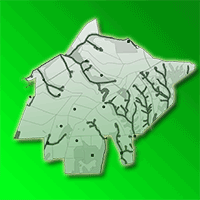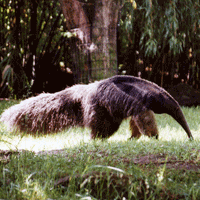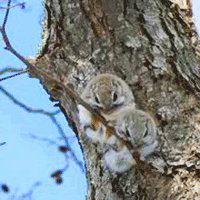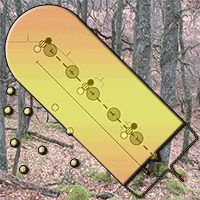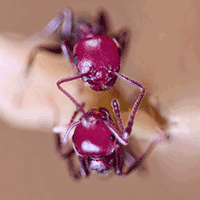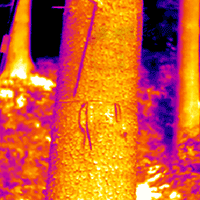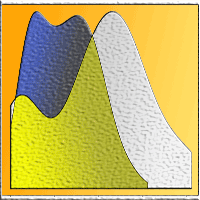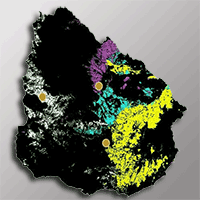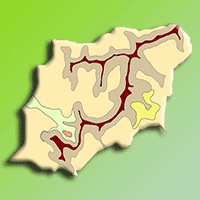Agricultural landscapes cover approximately 35% of Brazil and are the second greatest threat to biodiversity worldwide. In Brazil, seven millions hectars of land is covered with Eucalyptus plantations, which is considered to have low conservation value. However, studies have shown that heterogeneous silvicultural landscapes, made up of Eucalyptus matrices and patches dedicated to conservation, are able to support a considerable diversity of wild mammals. This study aims to assess the diversity and distribution patterns of medium-to-large-sized mammals in a silvicultural landscape in Angatuba, São Paulo, Brazil. Nineteen species were detected by camera traps within the study area. Diversity indices did not vary among habitat types (i.e., native vegetation, abandoned pasture and Eucalyptus plantations), suggesting that the species use the landscape as a whole. A relatively diverse range of predator species was found in the area, suggesting that future monitoring programs should focus on predator-prey relationships. A low diversity of frugivores was detected, indicating that management actions should be taken to facilitate their local recovery. Our results stress the fundamental importance of the conservation areas (Permanent Preservation Areas and Legal Reserve) in silvicultural landscapes, as these areas help maintain complexity of the landscape structure.
Keywords
, , , ,
Citation
Campos BM, Charters JD, Verdade LM (2018). Diversity and distribution patterns of medium to large mammals in a silvicultural landscape in south-eastern Brazil. iForest 11: 802-808. - doi: 10.3832/ifor2721-011
Academic Editor
Massimo Faccoli
Paper history
Received: Jan 04, 2018
Accepted: Oct 16, 2018
First online: Dec 14, 2018
Publication Date: Dec 31, 2018
Publication Time: 1.97 months
© SISEF - The Italian Society of Silviculture and Forest Ecology 2018
Open Access
This article is distributed under the terms of the Creative Commons Attribution-Non Commercial 4.0 International (https://creativecommons.org/licenses/by-nc/4.0/), which permits unrestricted use, distribution, and reproduction in any medium, provided you give appropriate credit to the original author(s) and the source, provide a link to the Creative Commons license, and indicate if changes were made.

Breakdown by View Type
(Waiting for server response...)
Article Usage
Total Article Views: 46617
(from publication date up to now)
Breakdown by View Type
HTML Page Views: 38172
Abstract Page Views: 3516
PDF Downloads: 4036
Citation/Reference Downloads: 6
XML Downloads: 887
Web Metrics
Days since publication: 2542
Overall contacts: 46617
Avg. contacts per week: 128.37
Article Citations
Article citations are based on data periodically collected from the Clarivate Web of Science web site
(last update: Mar 2025)
Total number of cites (since 2018): 6
Average cites per year: 0.75
Publication Metrics
by Dimensions ©
Articles citing this article
List of the papers citing this article based on CrossRef Cited-by.
(1)
Alves TRU, Fonseca RCB, Engel VL (2012)Mamíferos de médio e grande porte e sua relação com o mosaico de habitats na cuesta de Botucatu, Estado de São Paulo, Brasil [Medium and large sized mammalians and their relation to habitat patches at the Botucatu cuesta, state of São Paulo, Brazil]. Iheringia: Série Zoologia 102: 150-158. [in Portuguese]
CrossRef |
Gscholar
(2)
Athayde EA, Cancian LF, Morellato LPC (2016)The value of agricultural landscape for tropical trees. In: “Biodiversity in Agricultural Landscapes of Southeastern Brazil” (Gheler-Costa C, Lyra-Jorge MC, Verdade LM eds). De Gruyter Open, Berlin, pp. 87-103.
Online |
Gscholar
(3)
Cianciulli PL (1954)Introdução de essências florestais [Introduction to forestry bases]. Secretaria da Agricultura, Serviço Florestal, São Paulo, Brazil, pp. 30. [in Portuguese]
Gscholar
(4)
Clima Tempo (2016)São Paulo tem terceiro junho mais chuvoso em 73 anos [São Paulo has the rainiest June in 73 years]. Web site.
Online |
Gscholar
(5)
Colwell RK, Mao CX, Chang J (2004)Interpolating, extrapolating, and comparing incidence-based species accumulation curves. Ecology 85 (10): 2717-2727.
CrossRef |
Gscholar
(6)
Crooks KR (2002)Relative sensitivities of mammalian carnivores to habitat fragmentation. Conservation Biology 16 (2): 488-502.
CrossRef |
Gscholar
(7)
Donatti CI, Galetti M, Pizo MA, Guimaraes PR, Jordano P (2007)Living in the land of ghosts: fruit traits and the importance of large mammals as seed dispersers in the Pantanal, Brazil. In: “Seed Dispersal: Theory and its Application in a Changing World” (Dennis AJ, Schupp EW, Green RJ, Westcott DA eds). CSIRO Sustainable Ecosystems and the Rainforest CRC, Australia, pp. 104-121.
CrossRef |
Gscholar
(8)
Dotta G (2005)Diversidade de mamíferos de médio e grande porte em relação à paisagem da Bacia do Rio Passa-Cinco, São Paulo [Diversity of medium and large-sized mammals in relation to the landscape atributes in the Passa-Cinco river basin, São Paulo]. Master’s thesis, Universidade de São Paulo, Piracicaba, SP, Brazil, pp. 116.
CrossRef |
Gscholar
(9)
Dotta G, Verdade LM (2007)Trophic categories in a mammal assemblage: diversity in an agricultural landscape. Biota Neotropica 7 (2): 287-292.
CrossRef |
Gscholar
(10)
Dotta G, Verdade LM (2011)Medium to large-sized mammals in agricultural landscapes of south-eastern Brazil. Mammalia 75 (4): 345-352.
CrossRef |
Gscholar
(11)
Ekroos J, Odman AM, Andersson GK, Birkhofer K, Herbertsson L, Klatt BK, Olsson O, Olsson PA, Persson AS, Prentice HC, Rundlöf M, Smith HG (2016)Sparing land for biodiversity at multiple spatial scales. Frontiers in Ecology and Evolution 3: 145.
CrossRef |
Gscholar
(12)
Emmons L, Feer F (1997)Neotropical rainforest mammals: a field guide (2nd edn). University of Chicago Press, Chicago, USA, pp. 396.
Gscholar
(13)
Flynn DFB, Gogol-Prokurat M, Nogeire T, Molinari N, Richers BT, Lin BB, Simpson N, Mayfield MM, Declerck F (2009)Loss of functional diversity under land use intensification across multiple taxa. Ecology Letters 12 (1): 22-33.
CrossRef |
Gscholar
(14)
Foley JA, DeFries R, Asner GP, Barford C, Bonan G, Carpenter SR, Chapin FS, Coe MT, Daily GC, Gibbs HK, Helkowski JH, Holloway T, Howard EA, Kucharik CJ, Monfreda C, Patz JA, Prentice IC, Ramankutty N, Snyder PK (2005)Global consequences of land use. Science 309: 570-74.
CrossRef |
Gscholar
(15)
Foster RJ, Harmsen BJ (2012)A critique of density estimation from camera-trap data. Journal of Wildlife Management 76 (2): 224-236.
CrossRef |
Gscholar
(16)
Fraterrigo JM, Pearson SM, Turner MG (2009)Joint effects of habitat configuration and temporal stochasticity on population dynamics. Landscape Ecology 24: 863-877.
CrossRef |
Gscholar
(17)
Green RE, Cornell SJ, Scharlemann JPW, Balmford A (2005)Farming and the fate of wild nature. Science 307: 550-555.
CrossRef |
Gscholar
(18)
Hector A, Von Felten S, Schmid B (2010)Analysis of variance with unbalanced data: an update for ecology and evolution. Journal of Animal Ecology 79 (2): 308-316.
CrossRef |
Gscholar
(19)
IBGE (2015)Produção da extração vegetal e da silvicultura - PEVS [Production of the vegetable extraction and silviculture]. Web site.
Online |
Gscholar
(20)
IUCN (2015)The IUCN red list of threatened species. Version 2015-4. Web site.
Online |
Gscholar
(21)
Joppa LN, Pfaff A (2010)Global protected area impacts. Proceedings of the Royal Society B: Biological Sciences 278 (1712): 1633-1638.
CrossRef |
Gscholar
(22)
Jordano P, Galetti M, Pizo MA, Silva WR (2006)Ligando frugivoria e dispersão de sementes à biologia da conservação [Linking frugivory and seed dispersal to biological conservation]. In: “Biologia da Conservação: Essências” (Duarte CF, Bergallo HG, Dos Santos MA, Va AE eds). Editorial Rima, São Paulo, Brazil, pp. 411-436. [in Portuguese]
Gscholar
(23)
Lisboa MAM (2014)A política dos coronéis e a difusão do ensino primário em Angatuba/SP (1870-1930) [The politics of the crows and the diffusion of the elementary school in Angatuba/SP (1870-1930)]. PhD Thesis, Universidade de Campinas, São Paulo, Brazil, pp. 204. [in Portuguese]
Gscholar
(24)
Mackenzie DI, Nichols J, Sutton N, Kawanishi K, Bailey LL (2005)Improving inferences in population studies of rare species that are detected imperfectly. Ecology 86 (5): 1101-1113.
CrossRef |
Gscholar
(25)
Magnusson WE, Lawson B, Baccaro F, Castilho CV, Castley JG, Costa F, Drucker DP, Franklin E, Lima AP, Luizão R, Mendonça F, Pezzini F, Schietii J, Toledo JJ, Tourinho A, Verdade LM, Hero J (2014)Multi-taxa surveys: integrating ecosystem processes and user demands. In: “Applied Ecology and Human Dimensions in Biological Conservation” (Verdade LM, Lyra-Jorge MC, Piña CI eds). Springer, Berlin, Heidelberg, Germany, pp. 177-187.
CrossRef |
Gscholar
(26)
Marchini S (2014)Who’s in conflict with whom? Human dimensions of the conflicts involving wildlife. In: “Applied Ecology and Human Dimensions in Biological Conservation” (Verdade LM, Lyra-Jorge MC, Piña CI eds). Springer, Berlin, Heidelberg, pp. 189-209.
CrossRef |
Gscholar
(27)
Martin PS, Gheler-Costa C, Lopes PC, Rosalino LM, Verdade LM (2012)Terrestrial non-volant small mammals in agro-silvicultural landscapes of south-eastern Brazil. Forest Ecology and Management 282: 185-195.
CrossRef |
Gscholar
(28)
Maxwell S, Fuller RA, Brooks TM, Watson JEM (2016)The ravages of guns, nets and bulldozers. Nature 536 (7615): 143-145.
CrossRef |
Gscholar
(29)
May RM, Crawley MJ, Sugihara G (2007)Communities: patterns. In: “Theoretical Ecology: Principle and Applications” (May RM, McLean AR eds). Oxford University Press, Oxford, UK, pp. 111-131.
Online |
Gscholar
(30)
Medri IM, Mourão GM, Harada AY (2003)Dieta de tamanduá-bandeira (
Myrmecophaga tridactyla) no Pantanal da Nhecolndia, Brasil [Diet of giant-anteater (
Myrmecophaga tridactyla) at Nhecolndia Pantanal, Brazil]. Edentata 5: 29-34. [in Portuguese with English abstract]
Online |
Gscholar
(31)
Moktefi A, Shin SJ (2012)A history of logic diagrams. In: “Handbook of the History of Logic” (Gabbay DM, Pelletier FJ, Woods J eds). North-Holland, Elsevier, pp. 611-682.
CrossRef |
Gscholar
(32)
Noss RF, Quigley HB, Hornocker MG, Merrill T, Paquet PC (1996)Conservation biology and carnivore conservation in the Rocky Mountains. Conservation Biology 10: 949-963.
CrossRef |
Gscholar
(33)
O’Brien TG, Kinnaird MF, Wibisono HT (2003)Crouching tigers, hidden prey: Sumatran tiger and prey populations in a tropical forest landscape. Animal Conservation 6: 131-139.
CrossRef |
Gscholar
(34)
Pedrosa F, Salerno R, Padilha FVB, Galetti M (2015)Current distribution of invasive feral pigs in Brazil: economic impacts and ecological uncertainty. Natureza and Conservação 13: 84-87.
CrossRef |
Gscholar
(35)
Percequillo AR, Kierulff C (2009)Mamíferos [Mammals]. In: “Fauna Ameaçada de Extinção do Estado de São Paulo: Vertebrados” (Breassan PM, Kierulff MCM, Sugieda AM eds). Fundação Parque Zoológico de São Paulo, Secretaria do Meio Ambiente, São Paulo, Brazil, pp. 31-41. [in Portuguese]
Gscholar
(36)
Ripple WJ, Beschta RL (2006)Linking a cougar decline, trophic cascade, and catastrophic regime shift in Zion National Park. Biological Conservation 133: 397-408.
CrossRef |
Gscholar
(37)
Sowls LK (1984)The peccaries. University of Arizona Press, Tucson, AZ, USA, pp. 240.
Gscholar
(38)
Sparovek G, Berndes G, Klug IL, Barretto AGDOP (2010)Brazilian agriculture and environmental legislation: status and future challenges. Environmental Science and Technology 44 (16): 6046-6053.
CrossRef |
Gscholar
(39)
Stape JL, Binkley D, Ryan MG (2004)Eucalyptus production and the supply, use and efficiency of use of water, light and nitrogen across a geographic gradient in Brazil. Forest Ecology and Management 193 (1-2): 17-31.
CrossRef |
Gscholar
(40)
Timo TPC, Lyra-Jorge MC, Gheler-Costa C, Verdade LM (2015)Effect of the plantation age on the use of
Eucalyptus stands by medium to large-sized wild mammals in south-eastern Brazil. iForest 8: 108-113.
CrossRef |
Gscholar
(41)
Verdade LM (1996)The influence of hunting pressure on the social behavior of vertebrates. Revista Brasileira de Biologia 56 (1): 1-13.
Online |
Gscholar
(42)
Verdade LM, Gheler-Costa C, Lyra-Jorge MC (2016)The multiple facets of agricultural landscapes. In: “Biodiversity in Agricultural Landscapes of Southeastern Brazil” (Gheler-Costa C, Lyra-Jorge MC, Verdade LM eds). De Gruyter, Berlin, Germany, pp. 2-13.
CrossRef |
Gscholar
(43)
Verdade LM, Lyra-Jorge MC, Piña CI (2014a)Redirections in conservation biology. In: “Applied Ecology and Human Dimensions in Biological Conservation” (Verdade LM, Lyra-Jorge MC, Piña CI eds). Springer-Verlag, Heidelberg, Germany, pp. 3-17.
CrossRef |
Gscholar
(44)
Verdade LM, Penteado M, Gheler-Costa C, Dotta G, Rosalino LM, Pivello VR, Piña CI, Lyra-Jorge MC (2014b)The conservation value of agricultural landscapes. In: “Applied Ecology and Human Dimensions in Biological Conservation” (Verdade LM, Lyra-Jorge MC, Piña CI eds). Springer-Verlag, Berlin, Heidelberg, Germany, pp. 91-102.
CrossRef |
Gscholar
(45)
Verdade LM, Rosalino LM, Gheler-Costa C, Pedroso NM, Lyra-Jorge MC (2011)Adaptation of mesocarnivores (Mammalia: Carnivora) to agricultural landscapes in Mediterranean Europe and south-eastern Brazil: a trophic perspective. In: “Middle-Sized Carnivores in Agricultural Landscapes” (Rosalino LM, Gheler-Costa C eds). Nova Science Publishers, Inc., New York, USA, pp. 1-38.
Online |
Gscholar
(46)
World Bank (2018)Agricultural land (% of land area). Web site.
Online |
Gscholar
